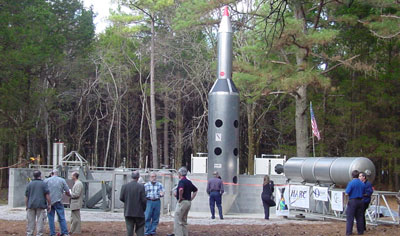A closer look at the Liberatorby Jeff Foust
|
| The full-scale Saturn 5 replica in Huntsville, illuminated by floodlights at night, takes on the appearance of a ghost from better times past. |
However, the spirit of innovation in launch vehicle development lives on in Huntsville. Last month the Huntsville-based High Altitude Research Corporation (HARC) announced plans to develop a suborbital vehicle, the Liberator, to compete for the X Prize. (See “Enter the Liberator”, October 13, 2003.) On Saturday, November 22, HARC gave a select audience its first detailed look at the vehicle, showing off hardware already constructed and discussing plans to fly the Liberator into space by late next year.
Liberator details
Saturday’s event—open just to the media, investors, and other invited guests—took place at HARC’s facility, located on about 50 hectares of land just east of Huntsville. Approaching the site on a gravel road that cuts through a thicket of trees, there’s little evidence of any activity going on, let alone an active rocket development program. Rounding a bend, though, and the modest facility comes into view, highlighted by a full-scale model of the Liberator passenger cabin standing nearly ten meters tall. “It’s like something out of a James Bond movie,” quipped Greg Allison, president of HARC.
When Allison and Liberator project manager Tim Pickens spoke in L.A. last month, they said they already had significant hardware available. At Saturday’s event they showed off some of that hardware. Besides the capsule model—an engineering test article, and not actual flight hardware—they displayed engines, propellant tanks, test stands, and a flight simulator. Combined, these items were designed to illustrate that HARC, while late to the X Prize race, plans to be a serious contender for the prize.
The HARC team also used the event to provide more technical details about the Liberator and its planned flight profile than what was first announced last month. As currently planned, Liberator will lift off from either a platform in the Gulf of Mexico or a peninsula in the US Virgin Islands. The spacecraft, carrying a pilot and two passengers stacked vertically, will be propelled by a booster using two 53,400-newton engines burning liquid oxygen and kerosene. HARC acquired the engine design from a defunct launch vehicle startup, Space America. With a total mass at liftoff of about 4,500 kilograms, the Liberator’s occupants will experience an acceleration of 2.5g. That acceleration will grow to 5g before engine burnout, although Pickens said his team is looking at ways to reduce the g-loads during flight.
| The Liberator capsule will reach a peak altitude of 107 kilometers just over three minutes after liftoff. |
One minute after liftoff, at altitude of nearly 30 kilometers, the booster’s engines will shut down and the booster will separate from the capsule. The booster will parachute to an ocean landing to be recovered and reused, per the requirements of the X Prize. The Liberator capsule itself will continue on its upwards trajectory, reaching a peak altitude of 107 kilometers just over two minutes later. Four minutes and 45 seconds after liftoff the capsule will begin decelerating by extending a set of speed brakes located near the nose of the capsule. Peak deceleration will again approach 5g; Pickens said this could be reduced by feathering the brakes in partially.
Nearly seven and half minutes after launch, the Liberator will have slowed down to subsonic speeds at an altitude of just under ten kilometers. At that point the capsule will deploy a parachute for the remainder of its descent. The capsule will splash down in the ocean about 15 kilometers away from the launch site. Allison said they are looking into both recovery boats and helicopters to recover the capsule and its crew. The vehicle is designed to be turned around for another flight within ten days—within the two-week requirement for the X Prize—with key engine components, such as injectors and the combustion chamber, rated for 20-25 flights before repair or replacement.
